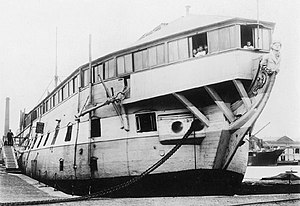HMS President (1829)

HMS President in South West India Dock, London, ca. 1880
|
|
| History | |
|---|---|
| Ordered: | 25 May 1818 |
| Builder: | Portsmouth Dockyard |
| Laid down: | June 1824 |
| Launched: | 20 April 1829 |
| Fate: | Sold for breaking up, 7 July 1903. |
| General characteristics | |
| Tons burthen: | 1,534 57⁄94 bm |
| Length: | 173 ft 5.5 in (52.870 m) |
| Beam: | 44 ft 10.75 in (13.6843 m) |
| Depth of hold: | 14 ft 2 in (4.32 m) |
| Sail plan: | Full-rigged ship |
| Complement: | 450 |
| Armament: |
|
HMS President was ordered in May 1818 to be built as a 58-gun frigate to the exact lines of the previous President, captured from the Americans in January 1815; this prize ship was re-classed as a 60-gun fourth rate in February 1817 but was taken to pieces in June 1818. The new replacement was laid down at Portsmouth Dockyard in June 1824 and launched on 20 April 1829; she was completed in 1830 but not commissioned until February 1832.
Rather than being armed identically to her namesake, her design was amended to complete her as a 52-gun frigate with an unarmed spar deck. She was later re-armed with thirty-two 32-pounder guns on the upper deck, and twenty 32-pounder carronades on the quarterdeck and forecastle.
After her first two years' commission on the North America and West Indies Station, she was refitted between February and May 1834. The years 1835–1838 were spent on the South American station. Thereafter she was at Portsmouth for several years before being fitted out as a flagship in 1845 and sent to the Cape of Good Hope for the next two-year commission.
Operations in support of the suppression of the slave trade led to President sending her boats in 1847 to attack an Arab stockade at Anjoxa, Mozambique Channel. The fighting, however, was not of a very serious description.
Returning from South Africa in 1847 to Chatham, she was refitted there in 1853 and sent to the Pacific Station. There she served as flagship until 1857.
Between 11 May and 7 September 1854, when news was received of the declaration of war at the start of the Crimean War, the British force on the China and Japan station consisted of President, Captain Richard Burridge, HMS Pique, Captain Sir Frederick William Erskine Nicolson, Bart., HMS Amphitrite, Captain Charles Frederick, HMS Trincomalee, Captain Wallace Houstoun, and HMS Virago, Commander Edward Marshall, all under Rear-Admiral David Price on President. The French force, under Rear-Admiral Auguste Febvrier-Despointes, consisted of Forte, Eurydice, Artemise, and Obligado. President participated in the Siege of Petropavlovsk and in a number of operations, none of which were carried through to a satisfactory conclusion. During the exchange of fire with the Russian batteries, Price retired to his cabin and shot himself. After suffering heavy casualties in a ground attack, the Allies withdrew, although President and Virago managed to capture and burn a Russian transport, the Sitka, of 10 guns, and take a small schooner, the Avatska, laden with stores. The Allies then left the area on 7 September.
...
Wikipedia
